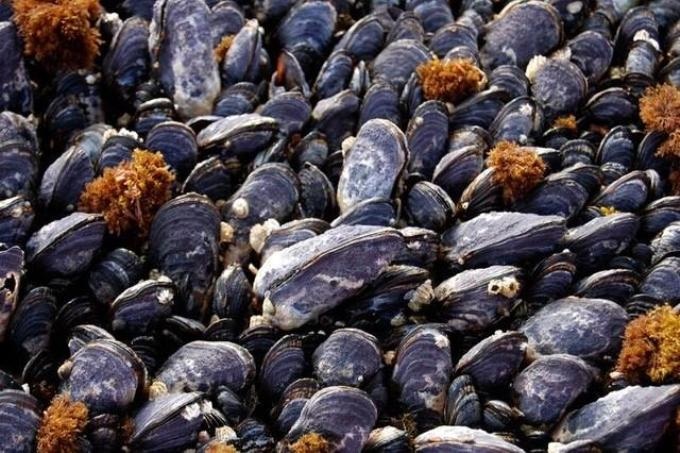Jan 8 2018
According to a new report by a research team from Florida State University, the ever increasing acidification of the ocean might be modifying the basic structure of California mussel shells.
 McCoy and her team found that ocean acidification has begun to change California mussel shells on a basic structural level. (Photo credit: Sophie McCoy)
McCoy and her team found that ocean acidification has begun to change California mussel shells on a basic structural level. (Photo credit: Sophie McCoy)
For many centuries, the mineralogical composition of California mussel shells has been comparatively uniform—cylindrical, long calcite crystals arranged in tidy vertical rows with crisp geometric regularity. However, in a research reported this week in the Global Change Biology journal, scientists have proposed that accelerating rates of acidification of the ocean are transforming the shell mineralogy on the most fundamental structural levels.
“What we’ve seen in more recent shells is that the crystals are small and disoriented,” stated Assistant Professor of Biological Science Sophie McCoy, who headed the study. “These are significant changes in how these animals produce their shells that can be tied to a shifting ocean chemistry.”
In order to record these modifications, the researchers analyzed an archival record of natural California mussel specimens gathered from Tatoosh Island, off the northwestern tip of Washington. The team compared present-day mussel shells with 1970s shells and also shells collected from the local Makah Cultural and Research Center, which dated back many centuries.
The team discovered that although shell mineralogy had been constant for thousands of years, shell specimens gathered within the past one and a half decades had undergone drastic structural transformation.
“When the mussels are ready to build their shells, they first lay down an amorphous soup of calcium carbonate, which they later order and organize,” stated McCoy. “More recent shells have just started heaping that calcium carbonate soup where it needs to go and then leaving it there disordered.”
They also discovered that the present-day shells manifested increased levels of magnesium, indicating that the shell formation process had been hindered.
In general, healthy shells are primarily formed of calcium carbonate and trace levels of magnesium included in a shell are due to ambient magnesium existing in the environment.
Elevated levels of skeletal magnesium also lead to modifications in the robustness of significant magnesium-oxygen bonds. The strength of these bonds is an instructive proxy for the extent of organization in shells.
When there’s not a clear geometric pattern in the skeleton, the bond strengths become more variable, and that’s what we’re seeing in modern shells. They’re not being organized.
When more magnesium is found in the skeleton, it signals that the organism has less control over what it’s making
Sophie McCoy, Assistant Professor of Biological Science
Such a trend in variable, disorganized structure of shells over the last 10 years is correlated to the quickly increasing rate of ocean acidification associated with climate change. However, although such environmental stressors have made the California mussel specifically vulnerable, McCoy stated that the same modification that occurs due to disordered skeletons might also prove to be a ray of hope for the species.
“An important theme of climate change science is that increased variability might be the new rule,” stated McCoy. “We know that climate change right now is happening faster than what the Earth has experienced before, but we also see that over these long timescales, things tend to plateau and stabilize. Variability is the basis of natural selection, and the fact that we now see so much variability in the mussels’ individual traits means there is potential for natural selection to act.”
McCoy first started analyzing the structure of California mussel shell in the year 2009 when, immediately starting her work for her doctorate, she observed evident visual contrasts between older and present-day shells.
“My job was to slice mussels in half and drill out the shell for isotope measurements, and by chance I noticed that older shells looked completely different,” she stated. “They were twice as thick, massive and took twice as long to cut. Eventually, we found that this was true for other older shells found at various sites throughout the region. It was sort of by accident. We could see the shells were changing, but we weren’t exactly sure what was going on.”
At present, many years following the initial observations, McCoy and her colleagues have zeroed in on the culprit—global climate change and its destabilizing impacts on the oceans.
However, McCoy stated that we need not get entirely pessimistic.
“I don’t know if this species will succeed in the future, but I have too much confidence in the natural processes of ecology and evolution to think that we’ll have barren oceans,” stated McCoy. “It’s true that we might not have as many mussel species, or that their populations might be smaller and have a more restricted range, but I don’t think that we’ll have an ocean with no mussels.”
Peter Chung and Nicholas Kamenos from the University of Glasgow worked together on this research, along with Catherine Pfister and Timothy Wootton from the University of Chicago. Marine Alliance for Science and Technology Scotland and the National Science Foundation supported the study. Archived shells was provided by The Makah Cultural and Resource Center.